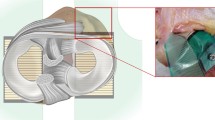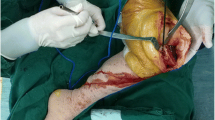Abstract
To perform an open-wedge high-tibial osteotomy (HTO), the medial proximal tibia is frequently exposed by partial distal release of the overlying insertion of the medial collateral ligament (MCL). Biomechanically, any release of the MCL can increase knee laxity when valgus stress is applied. Clinically however, post-surgical valgus instability following HTO with partial MCL release is an uncommon complication. It is known that the open-wedge procedure can re-tention an intact MCL by the width of the base of the wedge. However, this re-tentioning effect is uncertain in small wedge sizes, preexisting medial compartment laxity and in the presence of a partially detached MCL. Considering the good clinical results after HTO, we hypothesized that a partial release of the superficial MCL for HTO does not play a crucial role in stabilizing valgus forces in the human knee. We therefore measured the effect of partial versus complete release of the superficial MCL to determine medial knee laxity represented by the amount of medial joint opening (MJO) under valgus stress in this human cadaver study. In ten knee pairs, the superficial and deep MCL were sectioned in sequence with a standardized abduction force of 15 kp with a Scheuba apparatus applied. In group 1 (5 knee pairs), the superficial MCL was completely sectioned whereas in group 2 (5 knee pairs), sectioning of the superficial MCL was restricted to the anterior border to mimic the surgical exposure for an HTO. To account for the interindividual variability of ligamentous laxity, only increments of MJO within knee pairs were statistically evaluated. Stress radiography did not reveal any significant differences in increments of MJO between knee pair specimens with complete versus partial release of the superficial MCL. We disproved our hypothesis and concluded that the anterior fibers of the superficial MCL do play a crucial role in maintaining valgus stability in this biomechanical setting. Therefore, the release of the superficial MCL for open-wedge HTO should be kept to a minimum to decrease the potential of late valgus instability. This is especially important in patients with small wedge sizes and medial compartment laxity since the anterior MCL fibers are the main contributor to medial joint stability and the re-tentioning effect of the remaining MCL fibers is presumably decreased.



Similar content being viewed by others
References
Brantigan O, Voshell A (1943) The tibial collateral ligament: its function, its bursae, and its relation to the medial meniscus. J Bone Joint Surg 25:121–131
Conn K, Clarke M, Hallett J (2002) A simple guide to determine the magnification of radiographs and to improve the accuracy of preoperative templating. J Bone Joint Surg Br 84:269–272
Coventry MB (1985) Upper tibial osteotomy for osteoarthritis. J Bone Joint Surg Am 67:1136–1140
De Simoni C, Staubli A (2000) Neue Fixationstechnik für mediale open-wedge Osteotomien der proximalen Tibia. Schweiz Med Wochenschrift 119:130
Ellsasser J, Reynolds F, Omohundro J (1974) The nonoperative treatment of collateral ligament injuries of the knee in professional football players. J Bone Joint Surg Am 56:1185–1190
Fowler P, Tan L, Brown G (2000) Medial opening wedge high tibial osteotomy: how I do it. Operat Techniq Sports Med 8:32–38
Fujie H, Livesay G, Woo S, Kashiwaguchi S, Blomstrom G (1995) The use of a universal force-moment sensor to determine in-situ forces in ligaments: a new methodology. J Biomech Eng 117:1–7
Grood ES, Noyes FR, Butler DL, Suntay WJ (1981) Ligamentous and capsular restraints preventing straight medial and lateral laxity in intact human cadaver knees. J Bone Joint Surg Am 63:1257–1269
Hallen LG, Lindahl O (1965) Rotation in the knee-joint in experimental injury to the ligaments. Acta Orthop Scand 36:400–407
Hughston JC, Andrews JR, Cross MJ, Moschi A (1976) Classification of knee ligament instabilities. Part I. The medial compartment and cruciate ligaments. J Bone Joint Surg Am 58:159–172
Hughston JC, Eilers AF (1973) The role of the posterior oblique ligament in repairs of acute medial (collateral) ligament tears of the knee. J Bone Joint Surg Am 55:923–940
Indelicato P (1983) Non-operative treatment of complete tears of the medial collateral ligament of the knee. J Bone Joint Surg Am 65:323–329
Kennedy JC, Fowler PJ (1971) Medial and anterior instability of the knee. An anatomical and clinical study using stress machines. J Bone Joint Surg Am 53:1257–1270
Lobenhoffer P, De Simoni C, Staubli A (2002) Open-wedge high-tibial osteotomy with rigid plate fixation. Techniq Knee Surg 1:93–105
Lobenhoffer P, Agneskirchner JD (2003) Improvements in surgical technique of valgus high tibial osteotomy. Knee Surg Sports Traumatol Arthrosc 11(3):132–138
Markolf KL, Mensch JS, Amstutz HC (1976) Stiffness and laxity of the knee–the contributions of the supporting structures. A quantitative in vitro study. J Bone Joint Surg Am 58:583–594
Matsamuto H, Suda Y, Otani T, Niki Y, Seedhom B, Fujikawa K (2001) Roles of the anterior cruciate ligament and the medial collateral ligament in preventing valgus instability. J Orthop Sci 6:28–32
Paley D, Bhatnagar J, Herzenberg J, Bhave A (1994) New procedures for tightening knee collateral ligaments in conjunction with knee realignment osteotomy. Orthop Clin North Am 25:533–555
Patond KR, Lokhande AV (1993) Medial open wedge high tibial osteotomy in medial compartment osteoarthrosis of the knee. Natl Med J India 6:104–108
Scheuba G, Vosskohler E (1983) [Diagnosis of ligament injuries of the upper ankle joint]. Unfallchirurgie 9:341–344
Slocum DB, Larson RL, James SL (1974) Late reconstruction of ligamentous injuries of the medial compartment of the knee. Clin Orthop 100:23–55
Warren LA, Marshall JL, Girgis F (1974) The prime static stabilizer of the medical side of the knee. J Bone Joint Surg Am 56:665–674
Winker KH, Weller S (1990) Extra-ligamentous valgisation additive tibial head osteotomy. Indications-technic-complications-errors. Critical analysis. Z Orthop Ihre Grenzgeb 128:58–62
Author information
Authors and Affiliations
Corresponding author
Rights and permissions
About this article
Cite this article
Pape, D., Duchow, J., Rupp, S. et al. Partial release of the superficial medial collateral ligament for open-wedge high tibial osteotomy. Knee Surg Sports Traumatol Arthrosc 14, 141–148 (2006). https://doi.org/10.1007/s00167-005-0649-2
Received:
Accepted:
Published:
Issue Date:
DOI: https://doi.org/10.1007/s00167-005-0649-2




